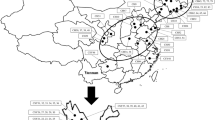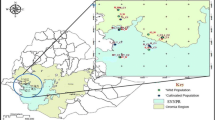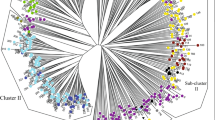Abstract
In this study, 17 simple sequence repeat (SSR) primer sets were used to analyze the genetic diversity, genetic relationships, and population structure among 81 accessions of two cultivated types of Perilla crop and their corresponding weedy types in East Asia and other countries. A total of 166 alleles were identified with an average of 9.8 alleles per locus. The average gene diversity (GD) value was 0.709. The average polymorphic information content (PIC) value was 0.679. The GD of each locus for accessions of cultivated var. frutescens, weedy var. frutescens, cultivated var. crispa, and weedy var. crispa were 0.557, 0.740, 0.429, and 0.509, respectively. Both weedy accessions exhibited higher GD and PIC values than their corresponding cultivated types. The cultivated and weedy types of the Perilla crop had much higher GD and PIC values in East Asia than in other countries. Particularly, in East Asia, the Perilla accessions from China showed higher SSR diversity than those from Korea, Japan, and other countries. Population structure analysis identified three groups, Group I, Group II, and an admixed group. Phylogenetic analysis produced four major clusters, but there was no clear geographic relationship between the two cultivated types of Perilla crop and their weedy types based on their regional distribution. This study demonstrated the utility of SSR analysis for performing genetic and population analysis of cultivated and weedy types of Perilla accessions in East Asia and other countries.
Similar content being viewed by others
Literature Cited
Ajmone-Marsan, P., P. Castiglioni, F. Fusari, M. Kuiper, and M. Motto. 1998. Genetic diversity and its relationship to hybrid performance in maize as revealed by RFLP and AFLP markers. Theor. Appl. Genet. 96:219–227.
Bostein, D., R.L. White, M. Skolnick, and R.W. Davis. 1980. Construction of a genetic linkage map in man using restriction fragment length polymorphisms. Am. J. Genet. 32:314–331.
Evanno, G., S. Regnaut, J. Goudet. 2005. Detecting the number of clusters of individuals using the software STRUCTURE: a simulation study. Mol. Ecol. 14:2611–2620.
Fukatsu, T. 1983. Plants for Lamp Oils. Hosei University Press, Tokyo. (in Japanese)
Hamza, S., W.B. Hamida, A. Reba?, and M. Harrabi. 2004. SSR-based genetic diversity assessment among Tunisian winter barley and relationship with morphological traits. Euphytica 135:107–118.
Honda, G., Y. Koezuka, and M. Tabata. 1990. Genetic studies of fruit color and hardness in Perilla frutescens. Jpn. J. Breed. 40:469–474.
Honda, G., A. Yuba, T. Kojima, and M. Tabata. 1994. Chemotaxonomic and cytogenetic studies on Perilla frutescens var. citriodora (Lemon Egoma). Nat. Med. 48:185–190.
Hu, Y., L.W. Sun, M.C. Neo, Y.X. Zhang, C.X. Wen, X.L. Xie, and Y.J. Liu. 2010. Primary identifications and palynological observations of Perilla L. in China. J. Syst. Evol. 48:133–145.
Ito, M., G. Honda, and K. Sydara. 2008. Perilla frutescens var. frutescens in northern Laos. J. Nat. Med. 62:251–258.
Kim, E.J., K.J. Sa, K.C. Park, and J.K. Lee. 2012. Study of genetic diversity and relationships among accessions of foxtail millet [Setaria italica (L.) P. Beauv.] in Korea, China, and Pakistan using SSR markers. Genes Genomics 34:529–538.
Koezuka, Y., G. Honda, S. Sakamoto, and M. Tabata. 1985. Genetic control of anthocyanin production on Perilla frutescens. Shoyakugaku Zasshi 39:228–231.
Koezuka, Y., G. Honda, and M. Tabata. 1986. Genetic control of the chemical composition of volatile oils in Perilla frutescens. Phytochemistry 26:859–863.
Kwon, S.J., J.K. Lee, N.S. Kim, J.W. Yu, A. Dixit, E.G. Cho, and Y.J. Park. 2005. Isolation and characterization of SSR markers in Perilla frutescens Britt. Mol. Ecol. Notes 5:454–456.
Lee, J.K., and N.S. Kim. 2007. Genetic Diversity and Relationships of Cultivated and Weedy types of Perilla frutescens Collected from East Asia revealed by SSR Markers. Korean J. Breed. Sci. 39:491–499.
Lee, J.K., S.J. Kwon, B.J. Park, M.J. Kim, Y.J. Park, K.H. Ma, S.Y. Lee, and J.H. Kim. 2007. Analysis of genetic diversity and Relationships of cultivated and weedy types of Perilla frutescens collected from Korea by using SSR markers. Korean J. Genet. 29:81–89.
Lee, J.K., M, Nitta, N.S. Kim, C.H. Park, K.M. Yoon, Y.B. Shin, and O. Ohnishi. 2002. Genetic diversity of Perilla and related weedy types in Korea determined by AFLP analyses. Crop Sci. 42:2161–2166.
Lee, J.K., and O. Ohnishi. 2001. Geographic Differentiation of Morphological Characters among Perilla crops and Their Weedy Types in East Asia. Breed. Sci. 51:247–255.
Lee, J.K., and O. Ohnishi. 2003. Genetic relationships among cultivated types of Perilla frutescens and their weedy types in East Asia revealed by AFLP markers. Genet. Resour. Crop Evol. 50:65–74.
Lee, J.K., B.J. Park, and N.S. Kim. 2003. Genetic diversity and relationships among cultivated types of Perilla frutescens and their weedy types in Korea and Japan. Korean J. Genet. 25:215–222.
Liu, K., and S.V. Muse. 2005. PowerMarker: an integrated analysis environment for genetic marker analysis. Bioinformatics 21:2128–2129.
Nagai, I. 1935. On “Shiso” and “Egoma”. Agric. Hortic. 10:2265–2273 (In Japanese)
Nei, M. 1973. Analysis of gene diversity in subdivided populations. Proc. Natl. Acad. Sci. USA 70:3321–3323.
Ni, J., P.M. Colowit, and D.J. Mackill. 2002. Evaluation of Genetic Diversity in Rice Subspecies Using SSR Markers. Crop Sci. 42:601–607.
Nitta, M. 2001. Origin of Perilla crops and their weedy type. PhD Diss., Kyoto University, Kyoto. p. 78
Nitta, M., J.K. Lee, and O. Ohnishi. 2003. Asian Perilla crops and their weedy forms: their cultivation, utilization and genetic relationships. Econ. Bot. 57:245–253.
Nitta, M., and O. Ohnishi. 1999. Genetic relationships among two Perilla crops, shiso and egoma, and the weedy type revealed by RAPD markers. Jpn. J. Genet. 74:43–48.
Pandey, A., K.C. Bhatt. 2008. Diversity distribution and collection of genetic resources of cultivated and weedy type in Perilla frutescens (L.) Britton var. frutescens and their uses in Indian Himalaya. Genet. Resour. Crop Evol. 55:883–892.
Park, Y.J., A. Dixit, K.H. Ma, J.K. Lee, M.H. Lee, C.S. Chung, M. Nitta, K. Okuno, T.S. Kim, E.G. Cho, and V.R. Rao. 2008. Evaluation of genetic diversity and relationships within an on-farm collection of Perilla frutescens (L.) Britt. using SSR markers. Genet. Resour. Crop Evol 55:523–535.
Park, Y.J., J.K. Lee, and N.S. Kim. 2009. Simple Sequence Repeat Polymorphisms (SSRPs) for Evaluation of Molecular Diversity and Germplasm Classification of Minor Crops. Molecules 14:4546–4569.
Powell, W., M. Morgante, C. Andre, M. Hanafey, J. Vogel, S. Tingey, and A. Rafalski. 1996. The comparison of RFLP, RAPD, AFLP and SSR (SSR) markers for germplasm analysis. Mol. Breeding 2:225–238.
Prasad, M., R.K. Varshney, J.K. Roy, H.S. Balyan, and P.K. Gupta. 2000. The use of microsatellites for detecting DNA polymorphism, genotype identification and genetic diversity in wheat. Theor. Appl. Genet. 100:584–592.
Pritchard, J.K., and W. Wen. 2003. Documentation for STRUCTURE software: Version 2.
Sa, K.J., S.H. Choi, M. Ueno, K.C. Park, Y.J. Park, K.H. Ma, and J.K. Lee. 2013. Identification of genetic variations of cultivated and weedy types of Perilla species in Korea and Japan using morphological and SSR markers. Genes Genomics 35:649–659.
Sa, K.J., J.A. Kim, J.K. Lee. 2012. Comparison of seed characteristics between the cultivated and the weedy types of Perilla species. Hortic. Environ. Biotechnol. 53:310–315.
Sa, K.J., J.Y. Park, K.J. Park, and J.K. Lee. 2010. Analysis of genetic diversity and relationships among waxy maize inbred lines in Korea using SSR markers. Genes Genomics 32:375–384.
Schontz, D., and B. Rether. 1999. Genetic variability in foxtail millet, Setaria italica (L.) P. Beauv.: Identification and classification of lines with RAPD markers. Plant Breed. 118:190–192.
Senior, M.L., J.P. Murphy, M.M. Goodman, and C. Stuber. 1998. Utility of SSRs for determining genetic similarities and relationships in maize using an agarose gel system. Crop Sci. 38:1088–1098.
Xia, X.C., J.C. Reif, A.E. Melchinger, M. Frisch, D.A. Hoisington, K. Beck, K. Pixley, and M.L. Warburton. 2005. Genetic diversity among CIMMYT maize inbred lines investigated with SSR markers: II. Subtropical, tropical midaltitude, and highland maize inbred lines and their relationships with elite U.S. and European maize. Crop Sci. 45:2573–2582.
Yamane, Y. 1950. Cytogenetic studies on the genus Perilla and Coleus I. chromosome number. Jpn. Genet. 25:220–220.
Author information
Authors and Affiliations
Corresponding author
Additional information
These authors are equally to this work.
Rights and permissions
About this article
Cite this article
Sa, K.J., Choi, S.H., Ueno, M. et al. Genetic diversity and population structure in cultivated and weedy types of Perilla in East Asia and other countries as revealed by SSR markers. Hortic. Environ. Biotechnol. 56, 524–534 (2015). https://doi.org/10.1007/s13580-015-0039-8
Received:
Revised:
Accepted:
Published:
Issue Date:
DOI: https://doi.org/10.1007/s13580-015-0039-8




